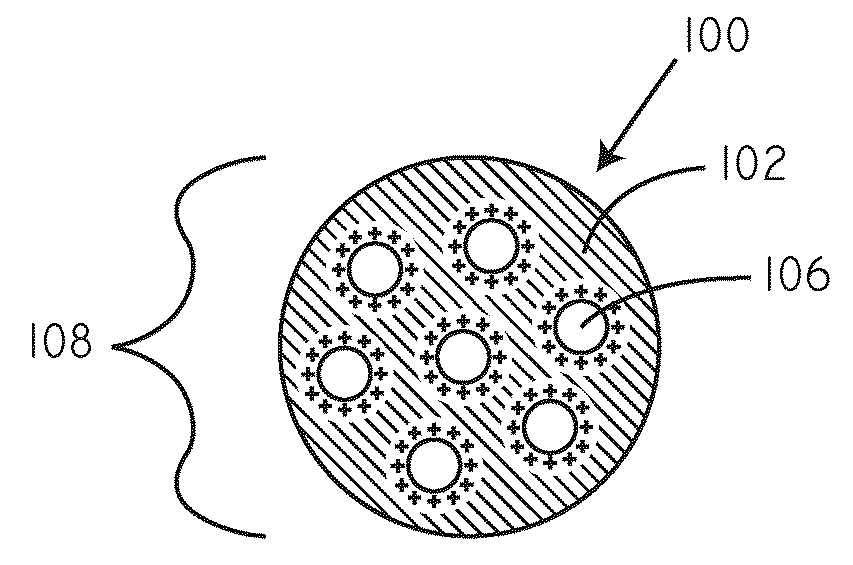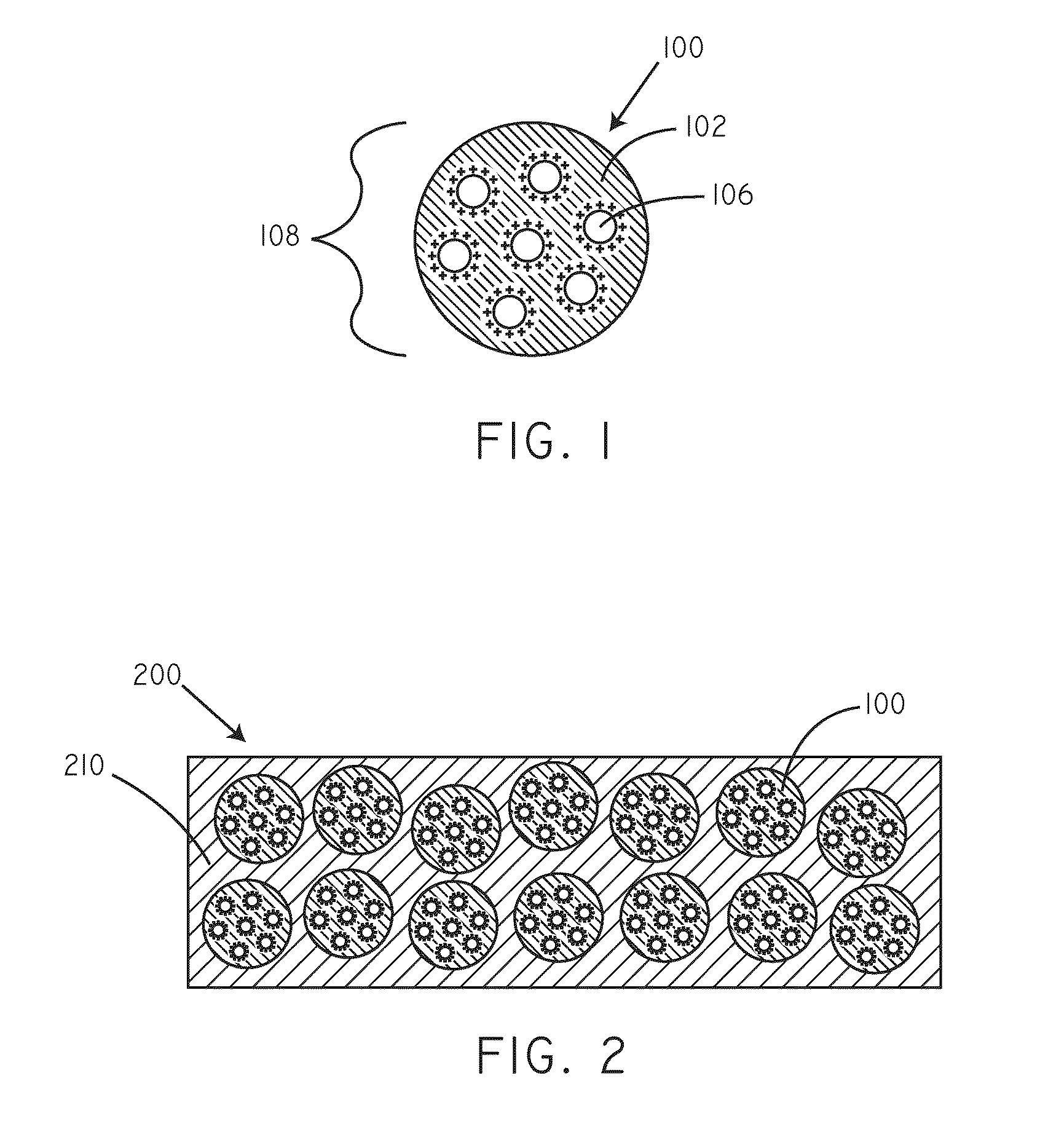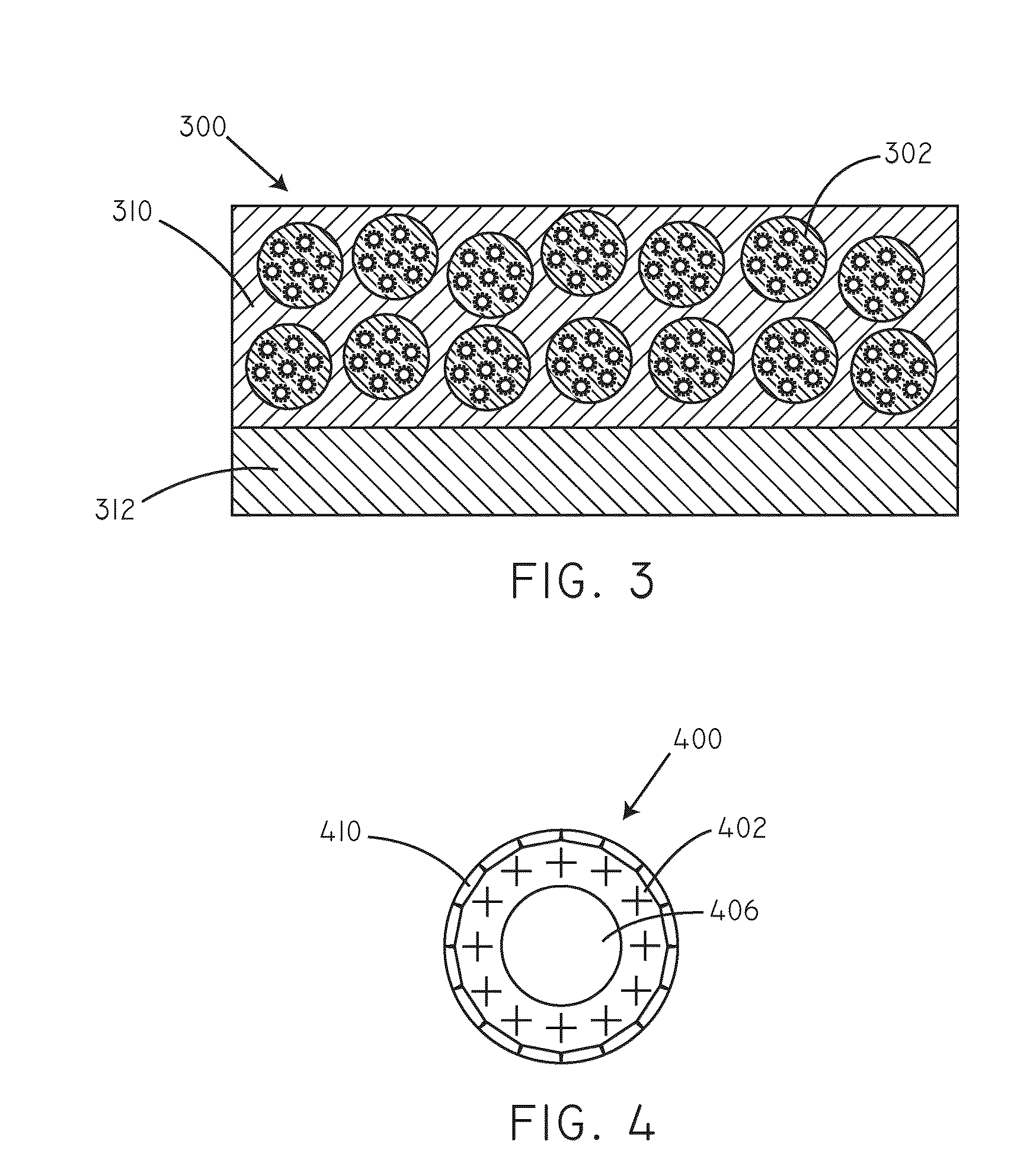Delivery of nucleic acid complexes from particles
a technology of nucleic acid complexes and particles, which is applied in the direction of microcapsules, genetic material ingredients, drug compositions, etc., can solve the problem of difficult steps
- Summary
- Abstract
- Description
- Claims
- Application Information
AI Technical Summary
Benefits of technology
Problems solved by technology
Method used
Image
Examples
example 1
In Situ Formation of Particles with Nucleic Acid Complexes
[0093]Polyethyleneimine (PEI) (branched 25 kDa, Sigma, St. Louis, Mo.) was dissolved in distilled deionized water (DDW) at 9 mg in 20 ml to obtain a solution having a concentration of amine groups of 10 mM. Using hydrochloric acid (HCl) the solution was adjusted to pH 7.4. 10 ul of fluorescein isothiocyanate (FITC) (Sigma, St. Louis, Mo.) 20 mg / ml was added to the solution. The progress of the reaction was followed by thin layer chromatography (TLC).
[0094]Using an N / P (nitrogen / phosphate) ratio of 6, DNA (25 ul, 1 ug / ul) ((herring sperm DNA, cleaved to 500-1000 bp, Lofstrand Labs Limited, Gaithersburg, Md.) was mixed with 6 ul 0.75 M NaCl or 6 ul of a sucrose solution in DDW (0.75 M). Fluorescein labeled-PEI as prepared above (10 mM amine conc., branched 25 kDa, 45 ul) was mixed with either 11.25 ul of 0.75 M NaCl or 11.25 ul of 0.75 M sucrose in DDW. Ending NaCl or sucrose concentration was 150 mM. The PEI solution was then ...
example 2
In Situ Formation of Particles with BSA, Maltodextrin or Dextran and Transfection
[0099]HEK 293 cells (ATCC, Manasass, Va.) were plated in 24-well plates at ˜8×104 cells / well. The cells were incubated with EMEM / 10% FBS for 24 hours prior to transfection.
[0100]Maltodextrin (MD070), Dextran 35-45 kDa and BSA (bovine serum albumin) were each dissolved separately at 100 mg / ml in 0.15 M sucrose.
[0101]Nucleic acid complexes were formed with GFP-DNA (green fluorescent protein) (Aldevron, Fargo, N. Dak.) and PEI at an N / P ratio of 24. DNA (20 ul, 20 ug) was mixed with 0.75M sucrose (20 ul) and distilled deionized water (DDW) (60 ul). PEI 25 kDa was dissolved in DDW at 9 mg in total of 20 ml to obtain a solution with a concentration of 10 mM of amine groups. Using HCl the solution was neutralized to a pH 7.4. A sucrose solution 0.75 M (40 ul) and DDW (16 ul) was added to 144 ul of the PEI. The final sucrose concentration in both solutions was 0.15 M. PEI was added dropwise to the DNA; total v...
example 3
Nucleation with Nucleic Acid Complexes
[0104]Polyethyleneimine (PEI, Sigma, 25 kDa branched) was dissolved at 9 mg in 10 mL distilled deionized water (DDW). Using HCl the initial basic pH was brought back to 7.4 and total volume was adjusted with DDW to 20 mL (creating 10 mM primary amino groups or “N”). Herring DNA 600-1000 bp (Lofstrand, Gaithersburg, Md.) was dissolved in DDW at 1 μg / μL. 1 μg DNA contains 3 nmol of negatively charged phosphate groups (“P”). DNA was mixed with PEI to provide DNA / PEI solutions with N / P ratios of 12 and 24, individually.
[0105]For a N / P ratio of 12, 5.5 μg DNA (5.5 μL) was mixed with 13.8 μL sucrose 0.75 M (2.57 g in 10 ml water, 25% w / v) to yield a 150 mM or 5% w / v solution. 20 μL of the PEI solution was mixed with 4 μL of the 0.75 M sucrose solution. The PEI mixture was dropped slowly into the DNA solution. After addition the mixture was vortexed briefly.
[0106]For a N / P ratio 24:2.75 μg DNA (2.75 μL) was mixed with 0.7 μL sucrose 0.75 M (2.57 g in 1...
PUM
| Property | Measurement | Unit |
|---|---|---|
| diameter | aaaaa | aaaaa |
| diameter | aaaaa | aaaaa |
| diameter | aaaaa | aaaaa |
Abstract
Description
Claims
Application Information
 Login to View More
Login to View More - R&D
- Intellectual Property
- Life Sciences
- Materials
- Tech Scout
- Unparalleled Data Quality
- Higher Quality Content
- 60% Fewer Hallucinations
Browse by: Latest US Patents, China's latest patents, Technical Efficacy Thesaurus, Application Domain, Technology Topic, Popular Technical Reports.
© 2025 PatSnap. All rights reserved.Legal|Privacy policy|Modern Slavery Act Transparency Statement|Sitemap|About US| Contact US: help@patsnap.com



